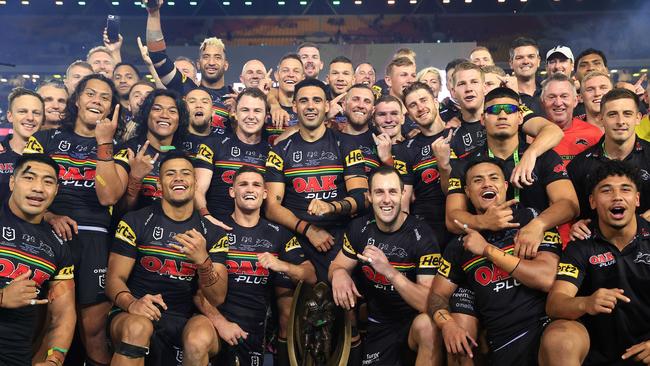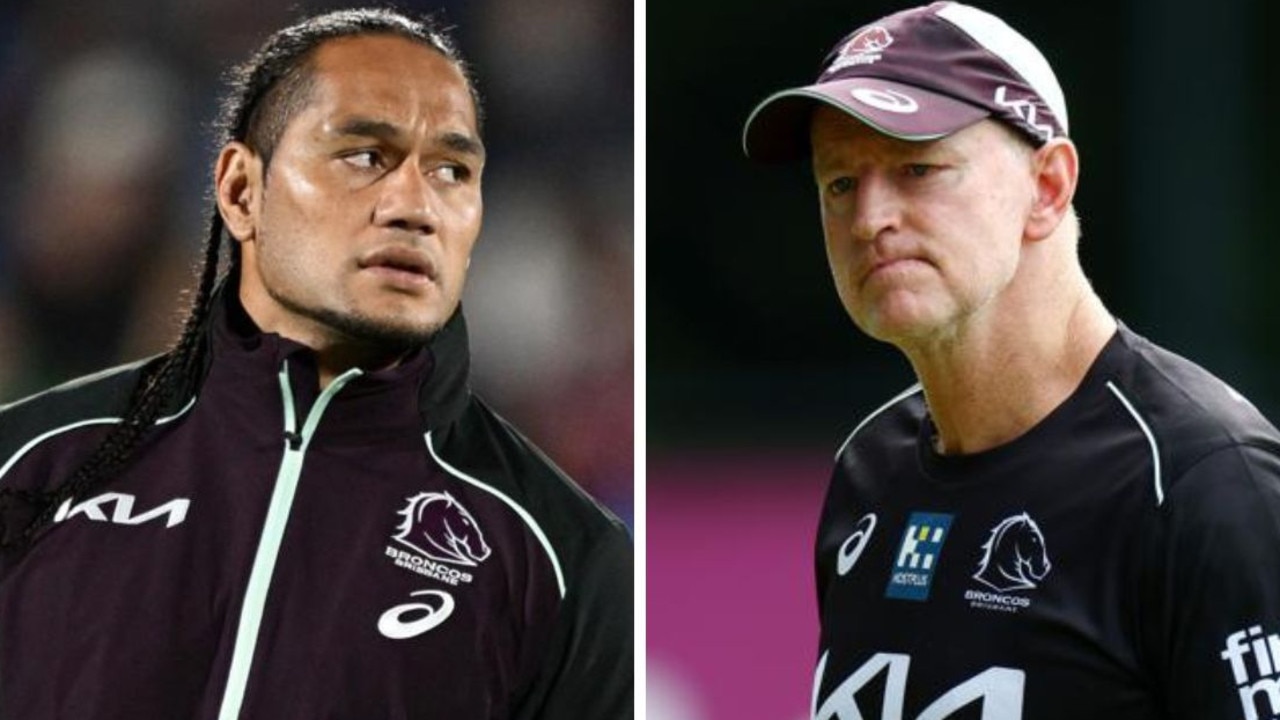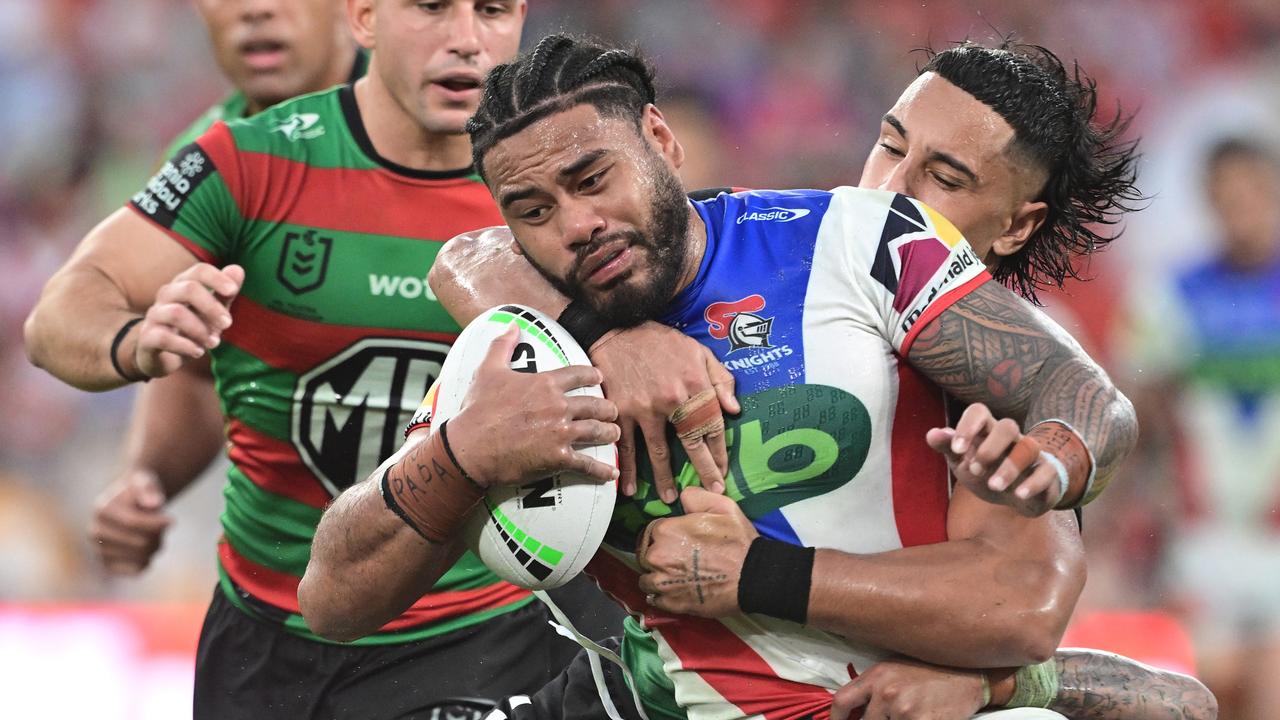NRL 2024: Penrith Panthers have lost 22 players to rival clubs since 2021 premiership
Since 2021 Penrith have lost enough players to fill the salary cap twice over. Now the reigning premiers are calling on the NRL to help ensure local talent remains at home.
NRL
Don't miss out on the headlines from NRL. Followed categories will be added to My News.
It’s the $25 million ‘growing’ issue for the NRL.
Since 2021, Penrith will have either farewelled – or in Jarome Luai’s case – about to say goodbye to, a whopping 22 players worth almost two full salary caps.
Which isn’t a problem when it comes to talent equalising.
But it is an evolving problem for NRL clubs that invest tens of millions in nurturing and developing talent only for rival teams to pinch those players away.
And there is a growing push by some to ensure local products remain at home.
Panthers Group CEO Brian Fletcher has watched elite juniors Stephen Crichton, Spencer Leniu and Isaiya Katoa leave the foot of the mountains.
The likes of Matt Burton, Viliame Kikau and J’Maine Hopgood, who were recruited as kids, also debuted at Penrith before earning bigger deals elsewhere.
By far the biggest was Luai, who was recently poached by the Wests Tigers on an irresistible five-year-deal worth $6 million from 2025.

“I feel sorry for the players that have had to leave because it has robbed them of the chance of winning competitions with us,” Fletcher said.
“I’m not suggesting they won’t win competitions at other clubs.
”But we want them to win titles for us.
“Matt Burton won one title and it could have been more but he had to go because he got offered a lot more money. He’s just one example.
“Those players would love to have stayed with their mates, but the system doesn’t allow that.
“We understand that there’s a cap and players have the right to earn as much money as they can, but salary cap exemptions could better support us to keep developed players.”
But while their competitors have wasted no time in picking apart the Panthers’ dynasty, Fletcher also has some allies when it comes to developing your own.
Coming up with a solution is the hard part.
Under current rules, clubs have access to a concession for developed and veteran players that is capped at $300,000 per season.
The amount a club qualifies for is then made exempt from the cap, although Canberra boss Don Furner is pushing for a bigger amount.
Under his proposal, clubs would receive a 5-20 per cent discount on their cap depending on when a player first entered the development system.
“Say a player comes off contract who is 21 years of age and is looking really good. You can offer him $500,000 but only $400,000 goes into the cap if he’s been in the system since Harold Matthews,” Furner said.
“The rival team is going to have to offer a lot more than $500,000 to get him if they decide to go to $700,000 and you don’t think it’s not worth it, well, then they can still get him.”
Another CEO floated the idea of introducing a transfer fee system used in many competitions across the globe, like in the English Premier League.
A transfer fee paid to the club would be attached to a developed player depending on how long they had been in the system.
The idea being the fee would help recoup some of the cost it takes to develop a player, while incentivising clubs to invest in their own pathways rather than part with a sizeable fee to poach talent from rivals.

Panthers CEO of football Matt Cameron would rather see more salary cap support.
“From an elite point of view, if I develop Jarome Luai and he plays NRL then I’ve got my benefit out of it,” Cameron said.
“Once a player plays NRL a fee becomes irrelevant in the current structure because I’ve done the work and received the benefit.
“The challenge now once I have developed him is ensuring that I can keep that elite player, and others, within the salary cap.
“The easiest way to encourage clubs to focus on development is if there is a salary cap benefit for that work in the end.
“For development clubs right now it doesn’t compensate adequately for the amount of work that’s done in development to get those players to the elite level.”
Few fans know that there is a development fee system already in place.
A club will receive a fee based on the type of contract the player has in place at the time of signing with a new club.
The development fee on a junior representative contract is $5,000 and capped at $50,000 for a player on an NRL contract.
This is one area South Sydney CEO Blake Solly believes should be improved.
“Salary cap concessions are important, but development fees can continue to be improved to help clubs that are heavily investing in development,” he said.
“Concessions in the cap is only one tool, there are other areas we can look at.”
NRL clubs are now spending anywhere between $2-3 million per year propping up pathways.
Figures that far exceed the $350,000 clubs receive in funding from the state leagues – via the NRL – to help with the cost of development.
The cost is only increasing.

The NRL is due to reveal revenues hit almost $690 million in 2023 and Fletcher believes part of the game’s growing wealth should be used to help clubs pay for development.
“It needs to be beefed up drastically,” he said.
“What we get is peanuts compared to what it costs you. I think the NRL should pick up the entire bill, they should allocate the amount each individual club is spending.
“We are investing into women’s development too. It’s okay for the NRL to say they have $300 million in the bank but some of that needs to be spread to the clubs for development.
“It shouldn’t be costing us millions to develop players, we are the ones putting the game on.
“It’s not money that is being wasted, in the long term it’s strengthening the game.”
The strength of the game’s talent pool has never been more crucial with the governing body committed to expanding the NRL competition to 20 teams in the next decade.
For the game to produce enough elite talent to sustain a high-quality competition with 20 teams, development must be a priority for the NRL.
“It’s pretty flattening to have a junior come through your ranks just go off to the highest bidder, there’s so much competition for talent, particularly if we want to expand,” interim Wests Tigers head of football Matt Betsey said.
“On the flip side of new franchises, if they start to incentivise them to attract talent, giving them allowances to attract talent, that’s going to be an issue for the game.”
Cameron believes work to improve and incentivise development across the board will help guarantee the game’s financial success in the future.
“It’s easy to bang on about how we have 8,000 juniors, 24 clubs etc., (but) the reality is, it’s not an equal playing field and it never will be,” Cameron said.
“But we need a model that can support development work at every club, a model everyone can aspire to work within.
“If we do better development work, we get a better product, we get a better TV audience. With a bigger TV audience, you don’t just get bigger broadcast deal but more money in the game, grassroots level. It’s a multiplier effect.”
It is understood the league has no immediate plans to make sweeping changes to salary cap concessions and funding to support pathways and development but the issue is on the NRL’s agenda.
“It’s an ongoing discussion with the NRL, they are aware of the predicaments clubs face and the importance of getting grassroots development right in our game,” Cameron said.
But the NRL was quick to respond to rugby union’s poaching of Joseph Aukuso-Suaalii, weighing up the decision to allow salary cap relief of up to $1 million from the rival code.
Even American college football talent could be discounted on the cap.
Furner argues that would betray the game’s junior nursery.
“There should be absolutely zero talk of incentivising buying union players through some type of exemption in your cap when you’re not doing more for your own juniors,” Furner said.
“That to me, makes zero sense at all.
“It’s nonsensical to think that you would reward kids who have stayed in union systems over a kid that’s stayed in a game they love and come through our development systems.”
More Coverage
Originally published as NRL 2024: Penrith Panthers have lost 22 players to rival clubs since 2021 premiership




